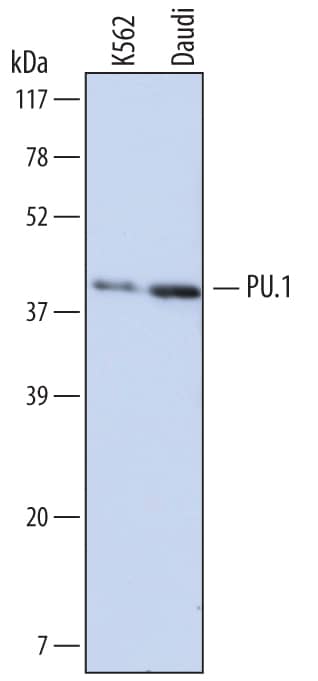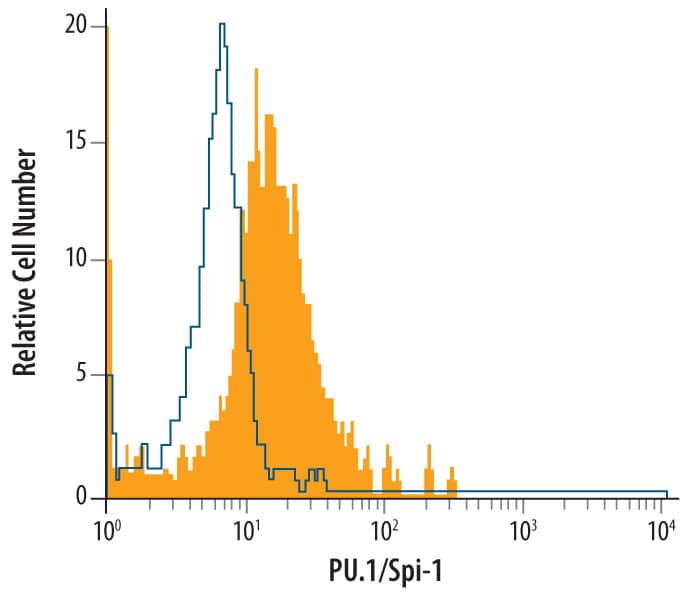Human PU.1/Spi-1 Antibody
R&D Systems, part of Bio-Techne | Catalog # MAB5870


Conjugate
Catalog #
Key Product Details
Species Reactivity
Human
Applications
CyTOF-ready, Intracellular Staining by Flow Cytometry, Western Blot
Label
Unconjugated
Antibody Source
Monoclonal Mouse IgG2B Clone # 732322
Product Specifications
Immunogen
E. coli-derived recombinant human PU.1/Spi-1
Met1-Lys169
Accession # NP_001074016
Met1-Lys169
Accession # NP_001074016
Specificity
Detects human PU.1/Spi-1 in direct ELISAs and Western blots. In direct ELISAs, no cross-reactivity with recombinant
human (rh) Spi-B, recombinant mouse (rm) PU.1/Spi-1, or rmSpi-B is observed. In Western blots, approximately 25% cross-reactivity with rhSpi-B and rmPU.1/Spi-1 is observed.
Clonality
Monoclonal
Host
Mouse
Isotype
IgG2B
Scientific Data Images for Human PU.1/Spi-1 Antibody
Detection of Human PU.1/Spi‑1 by Western Blot.
Western blot shows lysates of K562 human chronic myelogenous leukemia cell line and Daudi human Burkitt's lymphoma cell line. PVDF membrane was probed with 2 µg/mL of Mouse Anti-Human PU.1/Spi-1 Monoclonal Antibody (Catalog # MAB5870) followed by HRP-conjugated Anti-Mouse IgG Secondary Antibody (Catalog # HAF007). A specific band was detected for PU.1/Spi-1 at approximately 40 kDa (as indicated). This experiment was conducted under reducing conditions and using Immunoblot Buffer Group 1.Detection of PU.1/Spi‑1 in THP‑1 Human Cell Line by Flow Cytometry.
THP-1 human acute monocytic leukemia cell line was stained with Mouse Anti-Human PU.1/Spi-1 Monoclonal Antibody (Catalog # MAB5870, filled histogram) or isotype control antibody (Catalog # MAB004, open histogram), followed by Phycoerythrin-conjugated Anti-Mouse IgG Secondary Antibody (Catalog # F0102B). To facilitate intracellular staining, cells were fixed with paraformaldehyde and permeabilized with saponin.Applications for Human PU.1/Spi-1 Antibody
Application
Recommended Usage
CyTOF-ready
Ready to be labeled using established conjugation methods. No BSA or other carrier proteins that could interfere with conjugation.
Intracellular Staining by Flow Cytometry
2.5 µg/106 cells
Sample: THP‑1 human acute monocytic leukemia cell line fixed with paraformaldehyde and permeabilized with saponin
Sample: THP‑1 human acute monocytic leukemia cell line fixed with paraformaldehyde and permeabilized with saponin
Western Blot
2 µg/mL
Sample: K562 human chronic myelogenous leukemia cell line and Daudi human Burkitt's lymphoma cell line
Sample: K562 human chronic myelogenous leukemia cell line and Daudi human Burkitt's lymphoma cell line
Formulation, Preparation, and Storage
Purification
Protein A or G purified from hybridoma culture supernatant
Reconstitution
Sterile PBS to a final concentration of 0.5 mg/mL. For liquid material, refer to CoA for concentration.
Formulation
Lyophilized from a 0.2 μm filtered solution in PBS with Trehalose. *Small pack size (SP) is supplied either lyophilized or as a 0.2 µm filtered solution in PBS.
Shipping
Lyophilized product is shipped at ambient temperature. Liquid small pack size (-SP) is shipped with polar packs. Upon receipt, store immediately at the temperature recommended below.
Stability & Storage
Use a manual defrost freezer and avoid repeated freeze-thaw cycles.
- 12 months from date of receipt, -20 to -70 °C as supplied.
- 1 month, 2 to 8 °C under sterile conditions after reconstitution.
- 6 months, -20 to -70 °C under sterile conditions after reconstitution.
Background: PU.1/Spi-1
Long Name
Hematopoietic transcription factor PU.1
Alternate Names
OF, SFPI1, Spi-1, SPI-A, SPI1
Gene Symbol
SPI1
UniProt
Additional PU.1/Spi-1 Products
Product Documents for Human PU.1/Spi-1 Antibody
Product Specific Notices for Human PU.1/Spi-1 Antibody
For research use only
